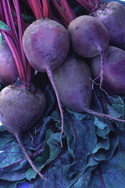
Photo © Steven Foster
Introduction
Red beetroot is one of the four useful forms of Beta vulgaris. It is most often cultivated as an annual vegetable. Beta vulgaris is descended from the wild sea beet (B. maritima), which is native to the coastal regions of Europe and North Africa..1
History and Cultural Significance
The genus name, Beta, may come from the Greek letter beta because the root was thought to resemble it.2 The name beet is derived from the French word bete meaning beast. English cooks thought the vegetable looked like a bleeding animal when it was cut open.2
The contemporary beet with its globular root did not appear in Europe until the 16th century CE. Ancient civilizations used the leaves of the beet as food and the root for medicinal purposes.2 Dioscorides’ 1st century CE Materia Medica recommended sniffing beet juice and honey up the nose to clear the head and relieve headache.3 A decoction of the leaves and roots were thought to provide a remedy for dandruff and nits (eggs of lice or other parasitic insects). In 1652, the herbalist Nicholas Culpepper recommended beets for skin infections.3
The beetroot is mainly used as food. It can be boiled, baked, pickled, or added to soup, as in Russian borscht. The leaves, which are also edible, are frequently eaten as greens. Various commercial beetroot products, such as beet juice, concentrated juice, powdered beetroot, and spray-dried powder are available as coloring agents in food, drug and cosmetic products.4,5
Modern Research
Beet is being investigated in lab and animal studies for potential immune system benefits.
Future Outlook
Cosmetic companies are increasingly moving towards products that are plant-based rather than animal-based. Most of the plant raw materials are being obtained from mass produced crops and are being used in items such as hand creams.6 The bulk of the commercial beetroot crop is grown in North America and northern Europe, totaling approximately 900,000 tons.7 In Europe, the major beetroot producers are France, Italy, Poland, and Russia. In the U.S., the major areas of production are New York, Oregon, Texas, and Wisconsin.7
To date, beetroot has not been genetically engineered as modifications could not be justified economically and, in part, because it has relatively few pest and disease problems. Since the methods for genetic engineering have been worked out for the sugar beet, there is the possibility that beetroot’s color or medicinal properties might be modified for use in the food and pharmaceutical industries respectively.7
References
1 Davidson A. The Oxford Companion to Food. New York: Oxford University Press; 1999.
2 Onstad D. Whole Foods Companion. White River Junction, VT: Chelsea Green Publishing Co.; 1996.
3 Chevallier A. The Encyclopedia of Medicinal Plants. New York: DK Publishing Inc.; 1996.
4 Leung AY, Foster S. The Encyclopedia of Common Natural Ingredients Used in Food, Drugs, and Cosmetics. 2nd edition. New York: John Wiley and Sons; 1996.
5 Pavlov A, Kovatcheva P, Georgiev V, Koleva I, Ilieva M. Biosynthesis and radical scavenging activity of betalains during the cultivation of red beet (Beta vulgaris) hairy root cultures. Tübingen, Germany: Verlag der Zeitschrift für Naturforschung 2003. Available at: http://www.znaturforsch.com/sc/57c/s57c0640.pdf. Accessed: November 9, 2004.
6 The cosmetics sector in Champagne-Ardenne Picardie. CAP Development March 2002. Available at: http://www.capdev.org/uk/pdf/CAP-cosmetiqueGB.pdf. Accessed April 14, 2004.
7 Nottingham S. Beetroot. 2004. Available at: http://ourworld.compuserve.com/homepages/Stephen_Nottingham/beetroot4.htm. Accessed March 18, 2005.
|